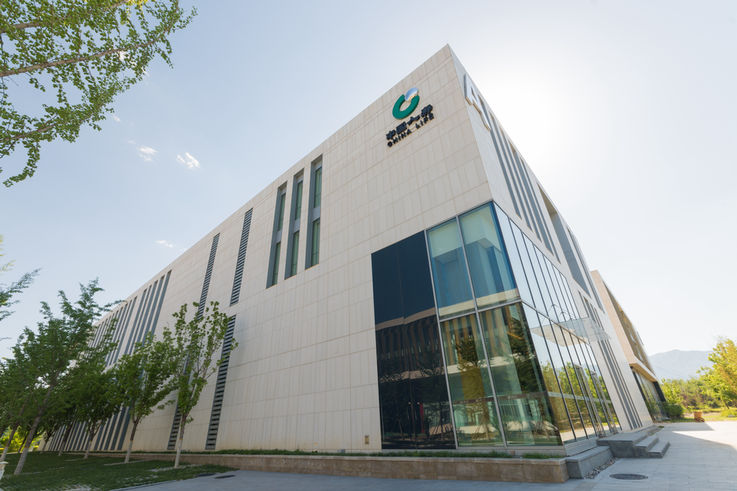Sustainability in LEED certified CLIC building in Beijing
Climate change is a global issue. The question of how climate protection objectives can be achieved is keeping the governments all over the world occupied - even in China. China is increasingly relying on sustainability and energy efficiency in buildings. A good example of it is the China Life Insurance Company (CLIC) R&D Centre in Beijing, which was certified with the international sustainability seal LEED.
Globally in trend: More energy efficient design of building
The People’s Republic of China is striving for climate neutrality by 2060. Therefore, the energy efficiency should be significantly boosted particularly in energy intensive industries. This also pertains to the Chinese construction and building sector, which causes extraordinarily high CO2 emissions in a worldwide comparison.

Green buildings benefit from intelligent building automation. © GEZE GmbH
China awards sustainable buildings
China has its own evaluation standard for green buildings, the Green Building Evaluation Label “China Three Star”. But the world’s best-known LEED certification system, with which the ecological, social, and economic quality of buildings is evaluated, is also much more common in China. A good example of it is: The R&D centre of the Life Insurance Company (CLIC) in Beijing has been awarded with the coveted LEED sustainability certificate.
Good to know for German architects and companies: Even the DGNB certificate awarded by the Deutschen Gesellschaft für Nachhaltiges Bauen e.V. [German Society for sustainable building] is recognised in China, but it is a great deal less common than the LEED certificate.
Building automation improves energy efficiency
An important factor to make the building more energy efficient is an intelligent building control: For example, in the CLIC office building in Beijing, heating, lights, air conditioning, cooling, shade control, door and window technology are linked together and automatically controlled. The energy consumption can be reduced significantly by intelligent automation. The reason: Sensors such as temperature sensor, air quality indicators, brightness sensors, movement detectors or weather stations are more energy efficient than humans in their response. Another advantage of the building automation (GA): The comfort and security are also noticeably improved.
Sustainable ventilation by automatic windows
Building automation improves not only the energy efficiency, but also the indoor air quality. If smart window systems such as our Powerchain and Slimchain electric chain drives are centrally linked with the building management technology, rooms can be ventilated and supplied with fresh air as needed. The advantage: Automated window ventilation consumes lesser energy than most of the mechanical ventilation systems. In addition, heating costs can be saved if ventilation and heating are jointly controlled via building management technology.

The China Life Insurance Company (CLIC) Beijing R&D Centre is LEED certified © GEZE GmbH
Successfully reduce energy consumption
The air conditioning and lighting systems of a building consume a lot of energy and make up for approximately 70 per cent of the entire energy consumption. Therefore, green buildings should be planned such that they use as much natural light and atmospheric cooling (or heat) as possible to minimise the energy consumption. The China Life Insurance Company (CLIC) Beijing R&D Centre in Beijing shows how it functions: The office building with a gross floor area of 391.051 m² has met the high energy efficiency requirements of the LEED sustainability seal. We are extremely proud that our door and window systems support the sustainable objectives of the building and satisfy the criteria of LEED certification.

Fresh air and pleasant indoor climate by intelligent window systems. © GEZE GmbH

Automatic revolving doors are user friendly and energy efficient. © GEZE GmbH
Natural fresh air supply and pleasant indoor climate.
The intelligent GEZE window systems at the shade control façade support the resource-conserving ventilation concept of the building. In addition, they also provide for an energy efficient indoor climate control since the costs for heating or cooling are reduced.
Using potentials for energy conservation
There is frequently a high potential to reduce the energy consumption especially in the entrance areas. For example, a vestibule with two consecutive sliding doors can significantly reduce the temperature exchange between the inner and outer area. Automatic revolving doors offer an elegant and efficient alternative: They ensure that the draught and weather conditions remain outside while visitors can comfortably enter the building. In the China Life Insurance Company (CLIC) Beijing R&D Centre, GEZE revolving doors ensure the security and hygiene of the visitors simultaneously reducing the energy consumption in the inner area.
GEZE products used in the CLIC building:
29 revolving doors:
- TSA 325 NT for representative building entrances with high footfall and high incident light
- TSA 160 NT for three or four-leaf doors with wide area of application --> not longer listed, alternative product is TSA 325 NT.
More than 200 window systems:
- Powerchain electric chain drives for large and heavy window elements
- Slimchain electric chain drive with especially narrow design
- E 3000 electric spindle drive for especially heavy roof window
- E 860
- E 820
- E 250 NT electric spindle drive in a compact design with wide area of application
Specialist advice for building planning
GEZE supports architects and specialist planner even in the early phases of the project in building planning and provides them with helpful information, for example, for integral planning with BIM objects.
Contact the GEZE experts in Germany via the architect hotline: +49-7152-203-112



